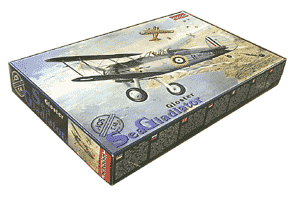

In the mid 1930s the Royal Navy required an urgent replacement for obsolete fighters like the Hawker Nimrod and Hawker Osprey. A truly modern aircraft (the future Fairey Fulmar) was being developed to the specification P.4/34; however, at the time of the Munich Crisis the Royal Navy was dangerously unprotected. The Gloster Company suggested a re-design of the Gladiator fighter according to Naval requirements. The first 38 planes were modified Gladiator Mk.IIs. A new brake lever was installed, and TR.9 marine radio equipment, as well as air speed indicators calibrated in knots. In December 1938, the first 13 interim Sea Gladiators were transferred to the Worsey Down base for training. Other machines were shared between Hetston, Eastlate and Doneybristle, and several more planes were delivered to Adena for further transfer to aircraft carriers in the Indian Ocean. At the beginning of 1939 the Sea Gladiator still did not have an adequate replacement, and the Navy signed a contract with the Gloster Company for the production of an additional 60 aircraft. In accordance with specification F. 36/37 this had to be properly marinised; apart from the brake lever, catapult clips and a ventral container with the rubber lifeboat were installed. At the 1st of September 1939 when WWII started, the Navy was equipped with 12 Sea Gladiators (Interim) and 42 late Sea Gladiators (sometimes this type is called Sea Gladiator Mk.II, however the name has never been official). In April 1940 operation Weserubung began: Germany intended to swiftly capture the Scandinavian countries. However, the Battle of Norway ruined its plans. On April 20th, the British Government decided to urgently help Norway. On April 22nd the aircraft carrier HMS Glorious with the Sea Gladiators of 802 and 804 squadrons aboard, left from Scapa Flow. The Battle of Norway was brief but fierce. On May 11th during one of their numerous fights a group of 15 Sea Gladiators faced five Ju-87s, two He-111s, and one He-115. The Royal Navy pilots managed to shoot down a Ju-87 and a He-115 without any losses of their own. A lot of future aces scored single victories, but overall the Battle of Norway was lost, and at the beginning of May, the British expeditionary forces returned home. Talking about the Sea Gladiator, we can't help mentioning the defense of Malta. This wartime episode entered history as an example of extreme heroism and self-sacrifice, and made the Sea Gladiator as famous as the Hurricane and Spitfire. In April 1940 18 Sea Gladiators from the aircraft carrier HMS Glorious were transferred to the newly created Hal Far Station Flight. Before then there was no fighter base on Malta. The Navy agreed that some of them could stay for the air defense of the island, and the rest of them had to be transferred aboard another aircraft carrier, HMS Eagle. When Italy entered the war on June 10th 1940, only three Sea Gladiators opposed all the aircraft the Reggia Aeronautica threw at the island. They were nicknamed 'Faith', 'Hope' and 'Charity' and during the early days of war they were the only British defense in the air. Their first victory was scored on June 22nd - Flt Lt George Burges shot down a SM79. Soon the Hal Far Station Flight was reorganized! as 261 Squadron of the Royal Air Force. For two more months, until the appearance of Hurricanes in Malta in some quantity, the Sea Gladiators were Malta's only hope. The last plane of this famous trio remained in service until the beginning of 1942. Nowadays this plane, N5220, is in the historical museum of the island and is one of the most honored exhibits. Gloster Sea Gladiator - the naval version of the famous British Gladiator fighter, modified for service at sea. The aircraft was widely used by the Royal Navy during the initial stages of WWII and took part in the Battle of Norway and in the Mediterranean. Three Sea Gladiators that defended Malta in summer 1940 entered history for their great heroism and sacrifice. In total 98 planes of this type were built. |


|